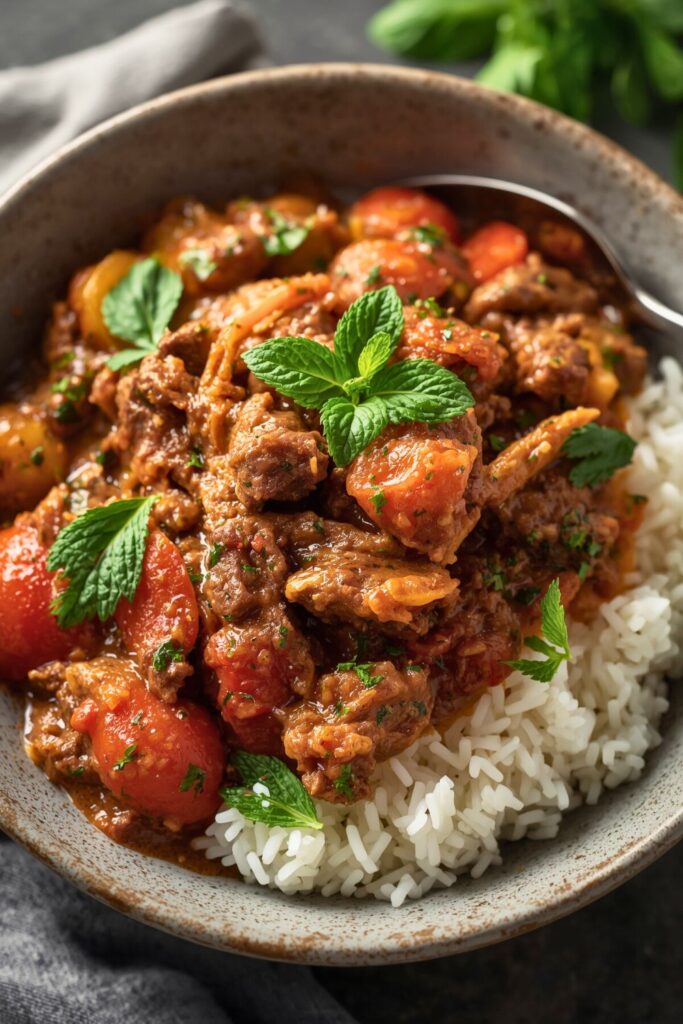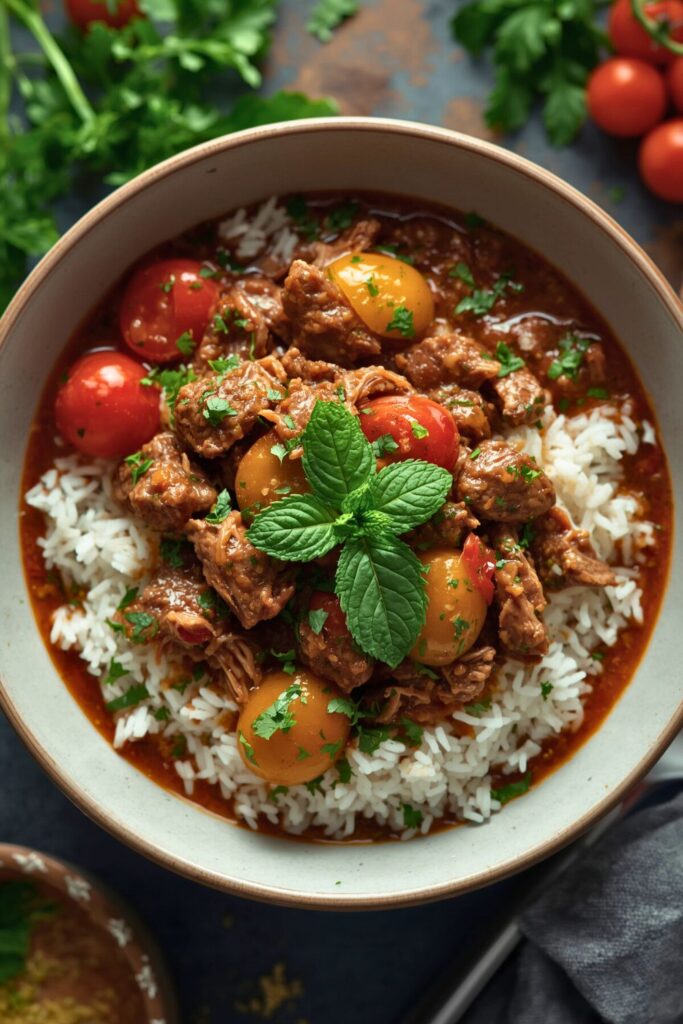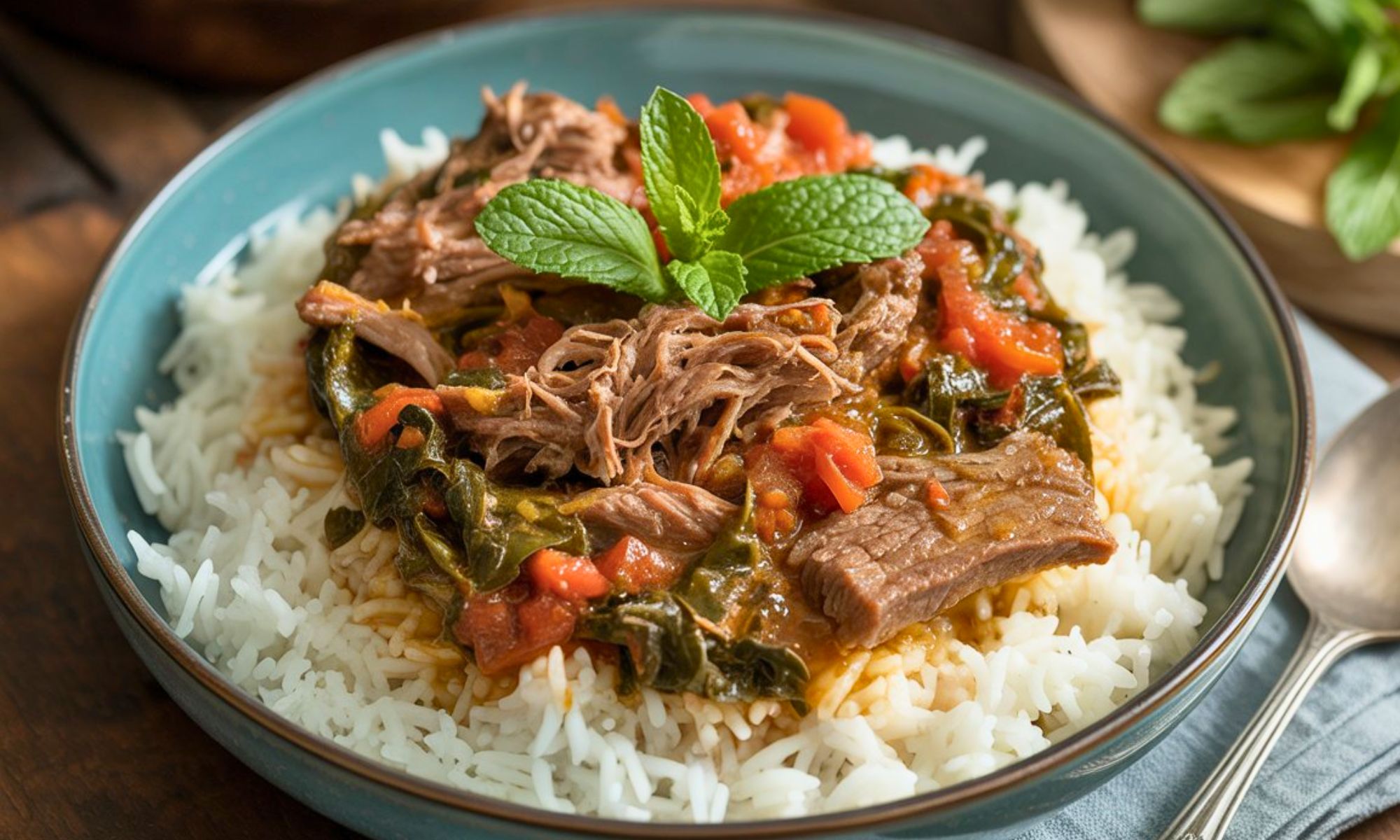You know that moment when the day’s been long, the house too quiet, and you need a dinner that delivers? Not just food, flavor that grabs you from the first whiff and won’t let go. That’s when a Persian Inspired Herb And Beef Stew With Rice becomes the hero, warm, fragrant, and so satisfying it can turn an ordinary night into one you’ll remember.
One rainy Sunday, with only a handful of herbs, some parsley, and a pound of beef, I set out to make something memorable. Onions sizzled, garlic filled the air, and fresh herbs tumbled into the pot, their aroma blending with tender beef in a green speckled broth.
When it was done, the stew was rich and fragrant, the beef melt in your mouth tender, and the saffron rice fluffy and golden. My Persian Inspired Herb And Beef Stew With Rice wasn’t just dinner, it was a plateful of comfort you’ll want to make again and again.
What Makes This Persian Herb & Beef Stew Revolutionary

Here’s what separates this Persian Inspired Herb And Beef Stew With Rice from every other stew you’ve made: Iranians treat herbs like Americans treat cheese. Generously. Unapologetically. With complete devotion.
We’re talking serious green power here. Parsley, cilantro, chives, and fenugreek create this complex flavor symphony that makes your standard beef stew taste like cardboard. The technique transforms these everyday herbs into something mystical.
Those herbs don’t just get stirred in casually. They get sautéed until dark and concentrated, creating an almost paste like base. Sounds strange? Trust the process. This step elevates ordinary ingredients into culinary gold.
The beef becomes fork tender through slow cooking. Kidney beans add creamy richness that balances those bright herbs perfectly. Dried limes contribute unique tartness that you can’t replicate with anything else.
Iranian rice isn’t just a side dish, it’s practically art. The tahdig technique creates golden, crispy bottoms that guests literally fight over. I’ve seen it happen.
Essential Ingredients For Authentic Persian Herb And Beef Stew
Here’s your shopping list, organized by cooking order:
For the herb mixture:
- 2 pounds mixed fresh herbs (parsley, cilantro, chives, fenugreek leaves)
- 1 large yellow onion, finely chopped
- 4 garlic cloves, minced
- 3 tablespoons vegetable oil
- 1 teaspoon sea salt
For the Persian Inspired Herb And Beef Stew base:
- 2 pounds beef chuck roast, cut into 2-inch chunks
- 1 cup dried red kidney beans, soaked overnight
- 5-6 dried Persian limes (limoo omani)
- 1 teaspoon ground turmeric
- 1 teaspoon black pepper
- 3 cups beef stock
- 2 tablespoons tomato paste
For the Persian rice:
- 2 cups aged basmati rice
- 4 tablespoons unsalted butter
- 1 tablespoon coarse salt
- Large pinch saffron threads
- 3 tablespoons hot water
Smart ingredient swaps save the day when specialty items play hide and seek. Can’t locate fenugreek leaves? Double your parsley instead. Those elusive dried limes? Fresh lime juice works, but add it during the final minutes.
Fresh herbs remain non negotiable here. Dried versions lack the volume and moisture needed for proper sautéing. However, you can adjust ratios based on availability. More cilantro compensates for missing chives beautifully.
Chuck roast, short ribs, or lamb shoulder all work wonderfully. Choose cuts that become tender through long, slow cooking. Avoid lean cuts, they’ll turn tough and chewy.
Here’s an insider secret about selecting herbs: smell them first. Fresh herbs should smell vibrant and green, never musty or wilted. Your nose knows quality better than your eyes.
Step by Step Persian Inspired Herb And Beef Stew Mastery

Let’s walk through this together, and I’ll save you from every mistake I made learning this dish.
Step 1: Herb preparation is everything
Wash those herbs like you mean it. Dry them completely, wet herbs create dangerous oil splatters during cooking. Chop them roughly; they’ll break down during sautéing anyway.
This step takes time. Embrace it. Pour wine, play music, make it enjoyable. You’re creating the foundation for something spectacular.
Step 2: The transformative herb sauté
Heat oil in your heaviest Dutch oven. Add all chopped herbs at once, yes, it’ll overflow initially. Cook over medium heat, stirring constantly.
Watch the magic happen. Herbs release water first, then concentrate into dark green paste. This takes 20-25 minutes. The color changes from bright to deep forest green. That’s your cue.
Don’t rush this step. Low heat prevents burning while developing complex flavors. The aroma becomes intoxicating, earthy, concentrated, almost smoky.
Step 3: Building the aromatic base
Add chopped onions to the herb mixture. Cook until translucent, about 8 minutes. The onions will absorb all those herb flavors and soften beautifully.
Stir in minced garlic for just one minute. Garlic burns easily, turning bitter and ruining everything you’ve built so far.
Step 4: Beef gets the royal treatment
Remove herb mixture temporarily. Brown beef chunks in the same pot, working in small batches. Don’t crowd them, proper browning needs space.
Each piece should develop golden caramelization on all sides. This step adds crucial flavor depth that you can’t achieve any other way.
Step 5: Everything comes together for Persian Inspired Herb And Beef Stew magic
Return herb mixture to the pot with browned beef. Add drained kidney beans, pierced dried limes, turmeric, and tomato paste. Stir everything together lovingly.
Pour in enough beef stock to barely cover ingredients. Bring to gentle boil, then reduce to lowest simmer possible. Cover and cook for 2.5 hours, stirring occasionally.
The stew is ready when beef falls apart with gentle pressure and beans are creamy inside. Taste and adjust seasoning, it should be complex, herby, and slightly tart.
The Science Behind Perfect Persian Inspired Herb And Beef Stew
Understanding what happens during cooking transforms you from recipe follower to confident cook. Those herbs contain volatile compounds that concentrate during sautéing, creating new flavor molecules that don’t exist in fresh herbs.
Long, slow cooking breaks down tough collagen in beef chuck, converting it to silky gelatin. This gives your Persian Inspired Herb And Beef Stew that luxurious, coating mouthfeel that makes it so satisfying.
Kidney beans release starch as they cook, naturally thickening the stew while absorbing all those incredible herb flavors. They become flavor sponges that burst with taste in every bite.
Dried limes contribute citric acid that tenderizes meat while brightening those earthy herb flavors. The bitter oils in the peels add complexity you can’t replicate with fresh citrus.
Turmeric provides more than golden color. Its compounds have natural preservative qualities and add subtle warmth that balances the herbs’ intensity.
Temperature control matters enormously here. High heat toughens meat and can burn delicate herb compounds. Low, steady heat creates tender meat and develops deep flavors.
Mastering Authentic Persian Rice Technique
Persian rice deserves its own masterclass because it transforms this Persian Inspired Herb And Beef Stew With Rice from good to extraordinary.
Start by rinsing basmati rice until water runs completely clear. This removes excess starch that makes rice gummy. Don’t skip this step, it’s crucial.
Boil rice in heavily salted water, think pasta cooking salty. Cook until just barely tender, about 8 minutes. It should still have slight bite since it’ll continue cooking.
Drain rice immediately and rinse with cool water to stop cooking. This prevents mushy rice disasters that ruin everything.
Create the tahdig magic by melting butter in the bottom of your pot. Layer drained rice on top, creating a pyramid shape. This allows steam circulation.
Cover tightly and cook on high heat for 3 minutes, then reduce to lowest setting for 45 minutes. You’ll hear gentle crackling as the bottom crisps.
Meanwhile, dissolve saffron in hot water. Mix with a few spoonfuls of cooked rice to create golden garnish rice that looks like edible sunshine.
Plate Persian Herb & Beef Stew Like a Pro
Presentation elevates this Persian Inspired Herb And Beef Stew With Rice from homestyle to restaurant worthy. Start with warmed plates, cold plates cool food too quickly.
Mound rice on one side, creating a small crater in the center. This catches stew juices beautifully and prevents plate flooding.
Ladle stew into the rice crater, allowing some to spill over naturally. This creates visual appeal and lets rice absorb those incredible flavors.
Crown everything with saffron rice like golden confetti. Break tahdig into shards and arrange around the plate, these crispy pieces add textural contrast.
Garnish with fresh herb sprigs if available. A few dried lime halves provide color contrast and hint at the dish’s flavor profile.
This Persian Inspired Herb And Beef Stew With Rice pairs magnificently with cooling yogurt mixed with cucumber and mint. The contrast cuts through rich, herby intensity perfectly.
Pomegranate juice complements the Persian theme beautifully. Wine lovers should try Pinot Noir or Côtes du Rhône, both handle the herb intensity gracefully.
Why Persian Herb & Beef Stew Should Be in Your Rotation

This Persian Inspired Herb And Beef Stew With Rice represents more than just dinner, it’s edible cultural exchange that brings Iranian warmth into your kitchen.
Every spoonful tells centuries old stories about a cuisine that elevated herbs from garnish to star ingredient long before farm to table became trendy.
The recipe improves dramatically overnight. All those complex flavors meld together, creating something even more delicious than day one. Plan ahead and thank yourself later.
Master this dish and you’ll never look at herbs the same way. You’ll understand why Iranians are so passionate about fresh ingredients and why they spend generous time creating memorable meals.
Make double batches and freeze portions. Future you will worship present you when you can thaw and reheat this masterpiece during busy weeks.
This Persian Inspired Herb And Beef Stew converts skeptics into believers. Even herb hesitant eaters fall for its complex, satisfying flavors.
Troubleshooting Your Persian Inspired Herb And Beef Stew Adventures
Stew turns out too thin: Uncover during final 30 minutes to reduce liquid. Alternatively, mix cornstarch with cold water and stir in gradually.
Beef remains tough: Continue cooking longer at lower temperature. Tough meat needs more time, not higher heat.
Herbs taste bitter: This happens from overcooking at high heat. Keep temperatures low and stir frequently during sautéing.
Rice sticks to pot: Use heavy bottomed pots and enough butter. Non stick doesn’t create proper tahdig, embrace the sticking.
Flavors seem flat: Add salt gradually until flavors brighten. Underseasoning kills even perfect technique.
Creative Variations for Your Persian Inspired Herb And Beef Stew
Once you’ve mastered the classic, try these inspired variations that honor the original while adding personal touches.
Substitute lamb shoulder for beef to create more traditional Persian flavors. Lamb’s richness pairs beautifully with these herbs.
Add pomegranate molasses during final cooking stages for sweet tart complexity that’s distinctly Persian.
Include baby eggplant pieces during the last hour for additional vegetable richness and authentic Persian touches.
Try different herb combinations based on availability. Dill, mint, and spinach all work wonderfully in various proportions.
Create vegetarian versions using mushrooms or extra beans. The herb technique remains the star regardless of protein choices.
Persian Inspired Herb and Beef Stew: Q&A
Can I make this Persian Inspired Herb And Beef Stew in a slow cooker?
You can adapt it, but you’ll sacrifice some flavor development. The crucial herb sautéing must happen on the stovetop, that’s where the magic occurs. Sauté herbs and aromatics first, then transfer everything to your slow cooker for the braising portion.
What if I can’t find dried Persian limes anywhere?
Fresh lime juice works as substitute, but add it during final minutes to prevent bitterness. Some Middle Eastern markets sell dried lime powder, another excellent alternative. Online ordering opens up more options too.
How long does Persian Inspired Herb And Beef Stew keep refrigerated?
This stew actually improves with age, keeping beautifully for 5-6 days refrigerated. Flavors deepen and become more complex over time. Rice is best made fresh when reheating leftovers, though.
Can I use frozen herbs for this recipe?
Fresh herbs are really essential here because you need proper volume and texture for effective sautéing. Frozen herbs contain too much water and won’t concentrate properly. If fresh isn’t possible, consider a different Persian recipe more forgiving with dried herbs.
Should this Persian Inspired Herb And Beef Stew be thick or soupy?
Aim for somewhere between, thick enough to cling to rice without running everywhere, but not paste like consistency. Think saucy stew rather than soup. Add broth if it becomes too thick during cooking.

Swiftly Captions by Tina Smith — Quick, flavorful food recipes made simple, bringing fresh inspiration to your kitchen every day






